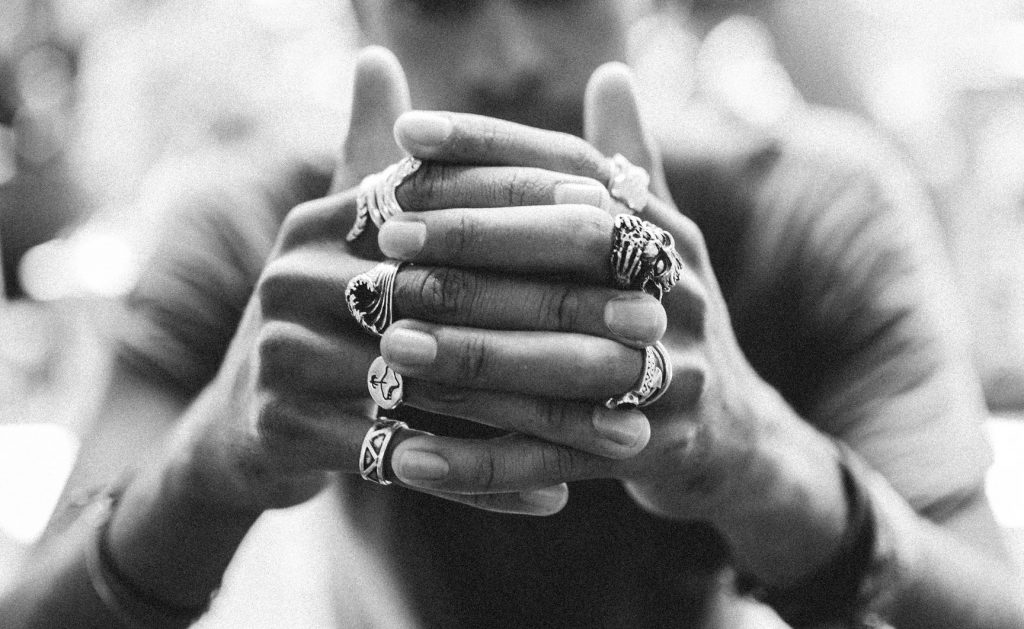How to know when a piece of jewelry is sterling silver?
Who hasn’t bought a jewlery piece being told it was silver to later find out it was not? It is certainly a very frequent issue, mostly if we are purchasing items at street markets, to untrustworthy vendors or if the product is underpriced for it to be real silver (because think about it, who would sell real solid silver for less that its value?)
Silver is a versatile chemical element. Sterling silver is 92.5 percent silver and 7.5 percent other metals, primarily copper. It is harder than pure silver. Pure silver is soft and often called “fine silver.”
Products often can be mistaken as silver if they are silver plated, or in other words made with a different metal (iron, cobalt, or nickel, copper, brass, stainless steel, among others) and then applied a silver silver layer over it, in that case you will need to be more careful with the use you give to them, since oxidation agents are likely to take the silver layer away.
In this article we will provide you with several tips to test your silver items at home and differentiate real silver from other similar metals.
- Look for a stampItems sold internationally as silver must be stamped accordingly. The most frequent stamps are 925, 900 or 800, which indicate the percentage of fine silver in the piece; 925 means that the piece is 92.5 percent silver, stamp of 900 or 800 means the piece is 90 percent or 80 percent silver.
If your item does not preset any stamp, this could be a reason to doubt the material’s veracity, however your resolution should not be based only on this test as there are countries that do not require stamping.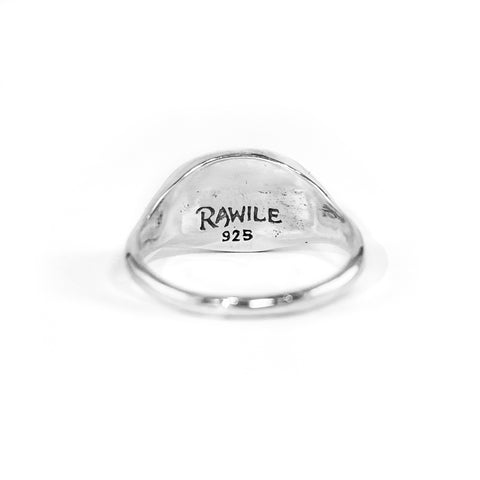
- Check if there is magnetic attractionTo perform this test you will need a strong magnet made out of neodymium. These magnets are easy to find at hardware stores or sometimes at craft stores. Silver is paramagnetic and exhibits only weak magnetic effects. If your magnet sticks strongly to the piece, it has a ferromagnetic core and is not silver.
However, there are other metals that look similar to silver and are not magnetic, so it is better to perform this test together with others if you’re still unsure about whether the piece of jewelry is genuine.
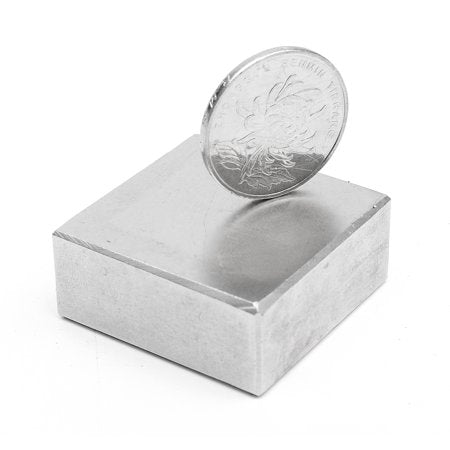
- Make sure there is no skin reaction
If after using your silver jewelry for a few times you are noticing it leaves a dark green stain on the skin’s surface that was right below the piece, then it is a clear sign that it is not real silver.
Your skin becoming stained happens because copper or another oxidizing metal has been sneaked in and mixed with silver, and therefore it is not real silver but an alloy of several metals.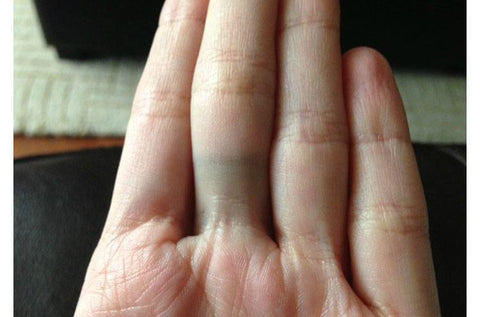
- Examine visual appearance
Tarnish is normal: Pure silver is highly tarnish resistant, but it is far too soft for use in everyday jewelry. Sterling silver has been the jewelry standard since the 14th century, it is an alloy (mix of metals) with a small amount of copper. This allows sterling silver to offer the luster we love, with durability needed for jewelry and other household goodsOver time, any sterling silver jewelry exposed to air will tarnish. Comprised of 92.5% silver and 7.5% other metals. It’s the other metals, typically copper, that make sterling silver tarnish. The copper reacts to moisture and sulfur in the air, causing the sterling silver tarnish. Silver tarnishes faster in areas with high humidity and air pollution. Chemicals like hairspray, perfume, deodorant, body lotion, bleach, etc., can speed up the tarnishing process.
Layers or flakes are not normal: Another visual difference between genuine silver and fake silver is whether it has any type of layering or flaking. This is a dead giveaway that your piece is plated or made with some other metal. Silver will not exhibit these signs.
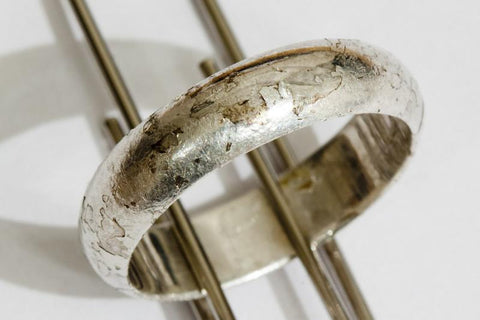
- Does it smell?
Luckily, real silver doesn’t have any specific smell to it. So this means that is your piece has a strong metal smell, something like sulfur or an old coin smell, it is certainly not silver. Most likely it is silver plated and made with copper or old zinc alloy.As creepy as it sounds and mainly if you are buying second hand or old jewels at a market or store, make sure to smell it first, it is a very precise indicator that the silver is or isn’t authentic
- Ice test (only for plain silver surfaces)
Probably you didn’t know that silver conducts heat way better than many metals, this means that we can test whether a piece is real silver just by using ice. Due to the higher amount of heat that is conducted through silver, the ice will start to melt just after placed over a silver surface, as if it had been placed over a heated surface!
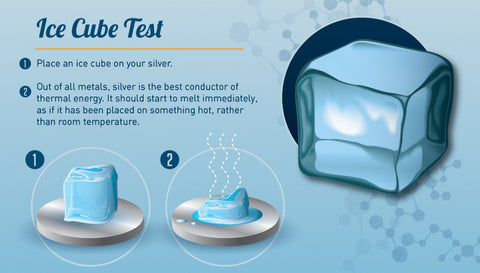
- Bleach test
Genuine silver tarnishes almost immediately when in touch with bleach, as it accelerates the oxidation process and creates a dark patina that can be also observed in old or artisan jewelry.This test won’t damage your jewelry, as you can easily clean the tarnish afterwards. However, you should know that bleach will also tarnish silver-plated items, so this test would not help you if you are concerned about your item being silver plated.
- Chemical test or acid test
The chemical analysis test is no doubts the most precise one to distinguish silver from other metals, however you should know beforehand that you will have to scratch your piece to perform this test, so it is preferable that you do this test for personal purposes as it is likely to damage your jewelry or silver item.Start by buying a silver testing kit, they usually come with a black tone plate that is meant to rub your silver onto, leaving a thick deposit on the stone in the shape of a line, around one centimetre (half inch) thick.
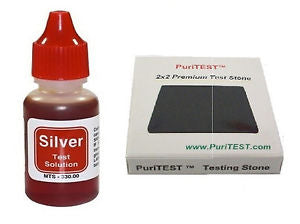
Apply a drop of the acid on the line that you just created on your stone and analyze the color that appears as a result of the chemical reaction. Follow the indications and color scale provided by your silver test if it differs from the general scale:
- Bright Red: Fine Silver
- Darker Red: 925 Silver
- Brown : 800 Silver
- Green : 500 Silver
- Yellow: Lead or Tin
- Dark brown: Brass
- Blue: Nickel
We hope these tips helped you learn how to test and identify sterling silver jewelry. Did you try any of these methods yourself? Do you have any other tips that might help our community? Let us know in the comments!
